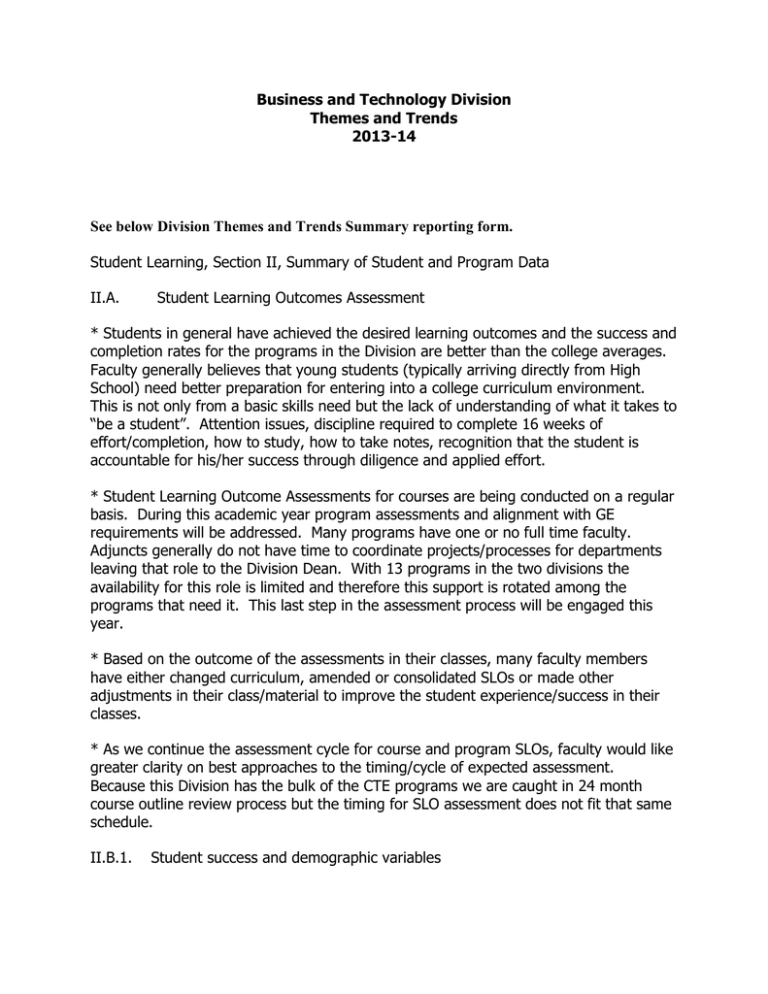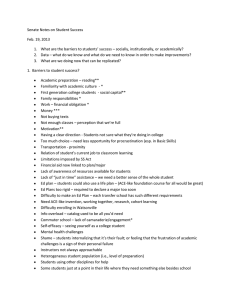Business and Technology Division Themes and Trends 2013-14
advertisement

Business and Technology Division Themes and Trends 2013-14 See below Division Themes and Trends Summary reporting form. Student Learning, Section II, Summary of Student and Program Data II.A. Student Learning Outcomes Assessment * Students in general have achieved the desired learning outcomes and the success and completion rates for the programs in the Division are better than the college averages. Faculty generally believes that young students (typically arriving directly from High School) need better preparation for entering into a college curriculum environment. This is not only from a basic skills need but the lack of understanding of what it takes to “be a student”. Attention issues, discipline required to complete 16 weeks of effort/completion, how to study, how to take notes, recognition that the student is accountable for his/her success through diligence and applied effort. * Student Learning Outcome Assessments for courses are being conducted on a regular basis. During this academic year program assessments and alignment with GE requirements will be addressed. Many programs have one or no full time faculty. Adjuncts generally do not have time to coordinate projects/processes for departments leaving that role to the Division Dean. With 13 programs in the two divisions the availability for this role is limited and therefore this support is rotated among the programs that need it. This last step in the assessment process will be engaged this year. * Based on the outcome of the assessments in their classes, many faculty members have either changed curriculum, amended or consolidated SLOs or made other adjustments in their class/material to improve the student experience/success in their classes. * As we continue the assessment cycle for course and program SLOs, faculty would like greater clarity on best approaches to the timing/cycle of expected assessment. Because this Division has the bulk of the CTE programs we are caught in 24 month course outline review process but the timing for SLO assessment does not fit that same schedule. II.B.1. Student success and demographic variables * In general departments report an increasingly diverse population of students with several reporting that the white student population (over the last five years) has moved into a minority status in their programs. There are also instances in some of the larger programs where the success rate of the minority students exceeds that of all other groups. * Male and Female students have almost identical success and retention rates. However, students over 30 have a higher success rate than younger students. II.B.2 Course delivery mode * In general, success rates in distance education have improved over time. While retention is generally higher in traditional courses, in some programs success is actually higher in the online sections. It is important to note that several programs do not have any online courses at this time. This would include Business Admin/Management, Electronics, Cosmetology, Administration of Justice and Rea Estate. With the exception of the Cosmetology Department there have been discussions within these departments concerning how to take some of the curriculum either online or to create a “flipped classroom” option for some of their courses. II.F. Additional Career Technical Education Data All programs/departments in this Division are designated as Career and Technical Education. Therefore, all comments made in this document are directly related to CTE. II.F.1. Degrees, certificates, and employment: Identify areas of accomplishment and areas of concern. * The programs in the Division all have a certificate option since they all have CTE status. We are working to develop new certificates in a number of disciplines. These certificates will include Certificates of Specialization that will be “stackable” and provide students that are pursuing CTE programs to accrue increasing levels of knowledge (leading to employment or advancement) at earlier levels than we have traditionally targeted with the larger certificates and degrees. Students have expressed concerns regarding the length of time it takes to complete programs that provide something they can use for employment. * Two programs have submitted the documentation (required for approval of new degrees) to the State Chancellors Office. The Electronics Department faculty submitted the application for their new degree in 2012 and we continue to wait for approval. The Computer Information and Science Department submitted their application for a new degree in April 2014 and we have not received any feedback at this time. Another reason for targeting small certificates is the ability to design, approve and deliver curriculum to students quickly in disciplines that are experiencing rapid change. The situation at the State Chancellor’s Office has been both frustrating and demoralizing for the faculty involved. * The various departments have pursed the transfer degrees (e.g., AA-Ts and AS-Ts), as they become available. We are pursuing the AS-T in CIS but approval of the final design has been delayed. Apparently the representatives of the CSU/CCC systems could not come to agreement on the details of the degree. * Employment in the disciplines represented in the Business and Technology Divisions is strong. All the programs are experiencing greater demand for their completers. The demand levels are validated through the use of Economic Modeling Systems Inc. research, research conducted by the CCCC Centers of Excellence system and interactions with members of our Industry Advisory Councils. General Commments:

